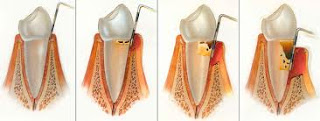This article provides an over-view of periodontal (gum) disease: what it is, how it develops, what the symptoms of it are and how patients can prevent it.
Periodontitis or periodontal disease and gum disease are one and the same thing: one of the greatest causes of tooth loss in the United States. Left untreated, this terrible oral affliction is, more so than any other oral offender, guilty of leaving people without a single original adult tooth in their mouths. Sounds shocking, doesn’t it? Well, it shouldn’t be because currently 30% of our population is completely edentulous (toothless) and in dire need of new teeth as a result of gum disease! It’s a prevalent condition and is remarkably easy to develop, given the right mix of oral hygiene negligence and bad lifestyle.
In order to increase awareness of the dangers of periodontitis, we shall be exploring what this disease is, what the symptoms of it are and how you can go about preventing it from laying waste to your beautiful, youthful smile.
What is Periodontitis?

Periodontitis or gum disease is an advanced oral bacterial infection of the gums surrounding the teeth. In its early stages, such a condition is referred to as “gingivitis”. If allowed to progress without treatment or intervention of any kind, this infection can become advanced and migrate deep down into the gingival sulci or tooth sockets (see image above). Here, safe from the roaming bristles of your toothbrush or any other hygienic measure, the bacteria are left allowed to proliferate. Before long, deep pockets of bacterial waste and other nasty toxins accumulate between the gum walls and the roots of the teeth causing tooth decay and ultimately, tooth loss.
What are the Signs and Symptoms of Periodontitis?

In the initial stages of the disease, when it’s still known as “gingivitis” you may notice:
- Red, inflamed gums,
- Swollen gums that form larger “bubbles” between the teeth,
- Gums that tear and bleed easily, especially when brushing and flossing,
- Chronic bad breath,
- Some tooth discoloration caused by visible accumulations of calculus on the teeth.
In the advanced stages of gum disease, you may notice any or all of the above-mentioned symptoms in addition to:
- Gums that have receded unnaturally from the crowns of the teeth, exposing the darker roots underneath and leaving you looking “toothy”,
- Tooth discoloration,
- A brown mottling between the teeth and at the gum margins,
- Oral lesions or sores,
- Loose teeth,
- Teeth that fall out.
How Can I Prevent Gum Disease?

Periodontitis is caused by oral bacteria, which is thankfully easy to keep under control with good oral hygiene and regularly scheduled appointments with the dentist and oral hygienist. Avoiding tooth loss and the need for new teeth also come down to certain lifestyle choices, such as staying away from:
- Smoking
- Heavy drinking
- Drug abuse
- Eating disorders
- An unhealthy diet high in sugar and starch.
If you manage your health and any illnesses you may have (such as diabetes) and if you look after your teeth and gums, you should be able to keep them in excellent condition for life. Any implant specialist will tell you that not even dental implants can rival the sophistication and longevity of your own biological technology!
No comments:
Post a Comment